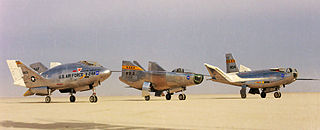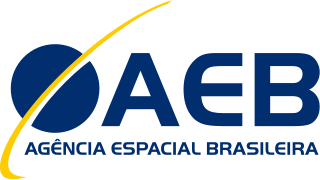Related Research Articles

Aerospace is a term used to collectively refer to the atmosphere and outer space. Aerospace activity is very diverse, with a multitude of commercial, industrial, and military applications. Aerospace engineering consists of aeronautics and astronautics. Aerospace organizations research, design, manufacture, operate, maintain, and repair both aircraft and spacecraft.

A lifting body is a fixed-wing aircraft or spacecraft configuration in which the body itself produces lift. In contrast to a flying wing, which is a wing with minimal or no conventional fuselage, a lifting body can be thought of as a fuselage with little or no conventional wing. Whereas a flying wing seeks to maximize cruise efficiency at subsonic speeds by eliminating non-lifting surfaces, lifting bodies generally minimize the drag and structure of a wing for subsonic, supersonic and hypersonic flight, or spacecraft re-entry. All of these flight regimes pose challenges for proper flight safety.

The Brazilian Space Agency is the civilian authority in Brazil responsible for the country's space program. It operates a spaceport at Alcântara, and a rocket launch site at Barreira do Inferno. It is the largest and most prominent space agency in Latin America.

A reusable launch vehicle has parts that can be recovered and reflown, while carrying payloads from the surface to outer space. Rocket stages are the most common launch vehicle parts aimed for reuse. Smaller parts such as rocket engines and boosters can also be reused, though reusable spacecraft may be launched on top of an expendable launch vehicle. Reusable launch vehicles do not need to make these parts for each launch, therefore reducing its launch cost significantly. However, these benefits are diminished by the cost of recovery and refurbishment.

The Office National d'Études et de Recherches Aérospatiales or ONERA, dubbed The French Aerospace Lab in English, is the French national aerospace research center. Originally founded as the Office National d’Études et de Recherches Aéronautiques in 1946, it was relabeled in 1963.

A spaceplane is a vehicle that can fly and glide like an aircraft in Earth's atmosphere and maneuver like a spacecraft in outer space. To do so, spaceplanes must incorporate features of both aircraft and spacecraft. Orbital spaceplanes tend to be more similar to conventional spacecraft, while sub-orbital spaceplanes tend to be more similar to fixed-wing aircraft. All spaceplanes as of 2024 have been rocket-powered for takeoff and climb, but have then landed as unpowered gliders.

The Italian Space Agency is a government agency established in 1988 to fund, regulate and coordinate space exploration activities in Italy. The agency cooperates with numerous national and international entities who are active in aerospace research and technology.

The Korea Aerospace Research Institute, established in 1989, is the aeronautics and space agency of South Korea. Its main laboratories are located in Daejeon, in the Daedeok Science Town. KARI's vision is to continue building upon indigenous launch capabilities, strengthen national safety and public service, industrialize satellite information and applications technology, explore the Moon, and develop environmentally-friendly and highly-efficient cutting-edge aircraft and core aerospace technology. Current projects include the KSLV-2 launcher. Past projects include the 1999 Arirang-1 satellite. The agency was founded in 1989. Prior to South Korea's entry into the Institute for Advanced Engineering (IAE) in 1992, it focused primarily on aerospace technology. As of May 2024, KARI is an affiliated research institute of the Korea AeroSpace Administration.

The Advanced Reentry Demonstrator (ARD) was a European Space Agency (ESA) suborbital reentry vehicle. It was developed and operated for experimental purposes, specifically to validate the multiple reentry technologies integrated upon it and the vehicle's overall design, as well as to gain greater insight into the various phenomenon encountered during reentry.

Masten Space Systems was an aerospace manufacturer startup company in Mojave, California that was developing a line of vertical takeoff, vertical landing (VTVL) rockets, initially for uncrewed research sub-orbital spaceflights and eventually intended to support robotic orbital spaceflight launches.

The Intermediate eXperimental Vehicle (IXV) is a European Space Agency (ESA) experimental suborbital re-entry vehicle. It was developed to serve as a prototype lifting body orbital return vehicle to validate the ESA's work in the field of reusable orbital return vehicles.
Scramjet programs refers to research and testing programs for the development of supersonic combustion ramjets, known as scramjets. This list provides a short overview of national and international collaborations, and civilian and military programs. The USA, Russia, India, and China (2014), have succeeded at developing scramjet technologies.
UP Aerospace, Inc. is a private spaceflight corporation headquartered in Denver, Colorado. UP Aerospace provides sub-orbital transportation for corporate, military and educational payloads, via their SpaceLoft XL sounding rocket launch vehicles.

Thales Alenia Space is a joint venture between the French technology corporation Thales Group (67%) and Italian defense conglomerate Leonardo (33%). The company is headquartered in Cannes, France.
The Future Launchers Preparatory Programme (FLPP) is a technology development and maturation programme of the European Space Agency (ESA). It develops technologies for the application in future European launch vehicles (launchers) and in upgrades to existing launch vehicles. By this it helps to reduce time, risk and cost of launcher development programmes.
Started in 2004, the programmes initial objective was to develop technologies for the Next Generation Launcher (NGL) to follow Ariane 5. With the inception of the Ariane 6 project, the focus of FLPP was shifted to a general development of new technologies for European launchers.
FLPP develops and matures technologies that are deemed promising for future application but currently do not have a sufficiently high technology readiness level (TRL) to allow a clear assessment of their performance and associated risk. Those technologies typically have an initial TRL of 3 or lower. The objective is to raise the TRL up to about 6, thus creating solutions which are proven under relevant conditions and can be integrated into development programmes with reduced cost and limited risk.

European eXPErimental Re-entry Test-bed (EXPERT) is a European Space Agency aerothermodynamics research programme. It was planned that vehicle will be launched on a Russian Volna launch vehicle and will provide knowledge and experience in the design and development of re-entry vehicles. As of 2012, one element in a European Space Agency push to develop vehicles capable of re-entry has been pushed back until at least 2013 as the agency seeks a launch alternative to the Russian submarine-launched Volna rocket which was withdrawn. One of its main goals was to test materials for ESA's Intermediate eXperimental Vehicle (IXV), an unmanned, delta-winged plane launched in 2015 aboard ESA's new Vega small-satellite launcher. Currently EXPERT remains in storage conditions in Turin.

The Japanese space program originated in the mid-1950s as a research group led by Hideo Itokawa at the University of Tokyo. The size of the rockets produced gradually increased from under 30 cm (12 in) at the start of the project, to over 15 m (49 ft) by the mid-1960s. The aim of the original research project was to launch a man-made satellite.
The Programme for Reusable In-orbit Demonstrator in Europe (PRIDE) is an Italian Space Agency programme that aims to develop a reusable robotic spaceplane named Space Rider in collaboration with the European Space Agency.

The Space Rider is a planned uncrewed orbital lifting body spaceplane aiming to provide the European Space Agency (ESA) with affordable and routine access to space. Contracts for construction of the vehicle and ground infrastructure were signed in December 2020. Its maiden flight is currently scheduled for the third quarter of 2025.

BluShift Aerospace is an employee-owned American aerospace firm based in Brunswick, Maine. Targeting the growing smallsat and cubesat launch markets, bluShift is developing suborbital sounding rockets and small-lift orbital rockets which will be launched from a proposed new spaceport in Maine. The company has received primary funding from NASAs SBIR grant program, the National Science Foundations I-Corps grant program, the Maine Technology Institute, and the Maine Space Grant Consortium. The company has active operations at the former Brunswick Naval Air Station and Loring Air Force Base.
References
- ↑ "General Information - CIRA". CIRA. Archived from the original on 2010-02-20. Retrieved 2009-01-11.
- 1 2 Tariq Malik (12 March 2007). "Italian Firm Hails Test of Unmanned Spacecraft Prototype". Space.com .
- ↑ "USV Program". CIRA. Archived from the original on 2011-07-22. Retrieved 2009-01-11.
- ↑ "European rocket research programs: USV, IXV, FLPP". HobbySpace. 2008-02-24. Archived from the original on 2012-08-29. Retrieved 2009-01-11.
41°07′16″N14°10′50″E / 41.12111°N 14.18056°E